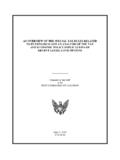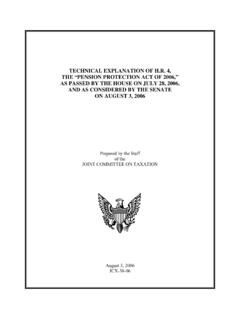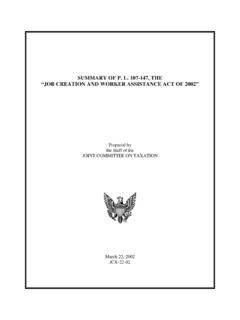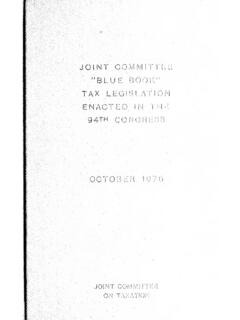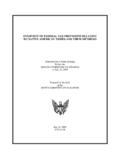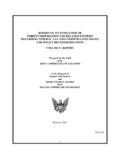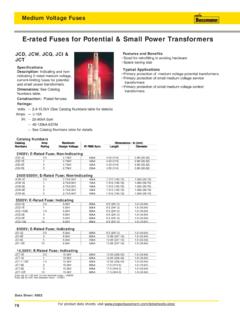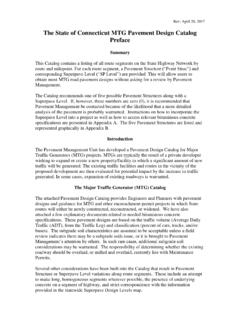Transcription of FEDERAL TAX PROVISIONS AFFECTING THE …
1 FEDERAL TAX PROVISIONS AFFECTING THE electric power industry Scheduled for a Public Hearing Before the SUBCOMMITTEE ON SELECT REVENUE MEASURES of the HOUSE COMMITTEE ON WAYS AND MEANS on June 13, 2001 Prepared by the Staff of the JOINT COMMITTEE ON TAXATION June 11, 2001 JCX-54-01 i CONTENTS Page 1 I. 2 A. Tax PROVISIONS Primarily AFFECTING Municipal electric Service Providers: Tax-Exempt 3 B. Tax PROVISIONS Primarily AFFECTING Investor-Owned 3 C. Tax PROVISIONS AFFECTING electric 4 D. Special Energy Tax Incentive 5 II. FEDERAL TAX PROVISIONS AFFECTING electric SERVICE 6 A. Tax PROVISIONS Primarily AFFECTING Municipal electric Service Providers: Tax-Exempt 6 B. Tax PROVISIONS Primarily AFFECTING Investor-Owned 18 1. Cost recovery of property used in the production, transmission, and distribution of 18 2. Other tax PROVISIONS of industry 26 a. Nuclear 26 b. Income recognition on the provision of 28 c.
2 Conservation 28 d. Customer deposits and 29 e. Cost of service 29 f. Cancellation of supply 30 g. Contributions in aid of 30 h. Involuntary 31 3. Deferred tax accounts: financial, regulatory, and tax 31 4. General corporate restructuring 32 C. Tax PROVISIONS AFFECTING electric 34 1. Overview of cooperatives and 34 2. Present and prior 35 Page ii D. Special Energy Tax Incentive 36 1. Tax credit for electricity produced by wind, closed-loop biomass, and poultry waste 36 2. Business energy tax credit for solar and geothermal 38 1 INTRODUCTION This document,1 prepared by the staff of the Joint Committee on Taxation, provides a description of present-law FEDERAL tax PROVISIONS relating to the electric power industry . The Subcommittee on Select Revenue Measures of the House Committee on Ways and Means has scheduled a public hearing on this subject on June 13, 2001. This document describes the principal current FEDERAL tax PROVISIONS specifically relating to the electric power industry , including PROVISIONS related to investor-owned, publicly-owned, and cooperatively-owned utilities, for non-utility generators, and other participants in the electric power industry .
3 Part I of the document is a summary. Part II is a description of present-law FEDERAL tax PROVISIONS AFFECTING electric service providers. 1 This document may be cited as follows: Joint Committee on Taxation, FEDERAL Tax PROVISIONS AFFECTING the electric power industry (JCX-54-01), June 11, 2001. 2I. SUMMARY In 1999, production and use of electricity comprised percent of total energy consumption in the United States,2 and in 1999 sales of electricity comprised percent of gross domestic product. In residential and commercial non-transportation uses, electricity comprised percent of total energy use, while electricity accounted for percent of the energy used by The residential sector is the largest end-user of electricity, having consumed percent of all electricity consumed in 1999. The industrial sector consumed percent of electricity, while commercial users consumed The electric power industry generally is comprised of three types of electric utilities--investor-owned utilities ("IOUs"), publicly owned utilities ("public power "), and electric cooperatives ("co-ops")--and of certain non-utility ("independent power ") producers.
4 Independent power producers sell most of their electricity to electric utilities that resell the power to final consumers. In 1999, IOUs provided percent of final electricity sales, public power percent, and co-ops The provision of electricity involves four distinct functions: generation, transmission, distribution, and retail sales. "Generation" involves the creation of electricity. The "transmission" of electricity refers to the transportation of electricity from generation sites to distribution centers. The "distribution" of electricity refers to the transportation of electricity from distribution centers to customers' homes and businesses. The "retailing" function involves metering and billing final customers. Retailing also may require the retailer to contract with generators and owners of transmission and distribution systems for the provision of electricity. Historically, most electricity was provided by vertically integrated suppliers that performed each of the four functions of generation, transmission, distribution, and retailing.
5 2 Energy Information Administration, Department of Energy, Annual Energy Review 1999 (July 2000). The Department of Energy estimates that in 1999 the United States consumed quadrillion British thermal units ( Btu ) of energy from all sources and that direct consumption of electricity and electrical system energy losses accounted for quadrillion Btu. 3 Energy Information Administration, Department of Energy, Monthly Energy Review (February 2001). Electricity comprised percent of energy used in transportation. 4 Id. at 101. 5 Energy Information Administration, Department of Energy, electric Sales and Revenue 1999 (October 2000). These figures are based on millions of kilowatt hours, rather than dollars of sales. In 1999, over trillion kilowatt hours of electricity were sold by the utilities. Of that total, roughly trillion kilowatt hours were sold by IOUs, 499 billion kilowatt hours by public power utilities, 288 billion kilowatt hours by co-ops, and 52 billion kilowatt hours by direct sales from FEDERAL power authorities to final consumers.
6 3 This pamphlet describes present-law FEDERAL tax PROVISIONS applicable to the electric power industry . A. Tax PROVISIONS Primarily AFFECTING Municipal electric Service Providers: Tax-Exempt Financing Interest on debt incurred by States or local governments is excluded from the income of the lender ( bondholder ) if the proceeds of the borrowing are used to carry out governmental functions of those entities or the debt is repaid with governmental funds of those entities. Interest on bonds that nominally are issued by States or local governments, the proceeds of which are used (directly or indirectly) by a private person and payment of which is derived from funds of such a private person ("private activity bonds"), is taxable unless the purpose of the borrowing is approved specifically in the Internal Revenue Code (the "Code") or in another provision of a revenue Act. The term "private person" generally includes the FEDERAL Government and all other individuals and entities other than States or local governments.
7 The provision of electric service (generation, transmission, distribution, and retailing) is a governmental activity eligible for financing with governmental tax-exempt bonds when the financed facilities are used by or paid for by a State or local government entity ( , by public power ). As with other governmental activities, public power also is eligible for limited tax-exempt financing of working capital costs ( , salaries of employees and similar expenses). Except as described in Part II, private IOU and co-op electric service providers generally are not eligible for tax-exempt financing of their facilities. B. Tax PROVISIONS Primarily AFFECTING Investor-Owned Utilities Cost recovery of property used in the production, transmission, and distribution of electricity A taxpayer generally must capitalize the cost of property used in a trade or business and is allowed to recover the cost over time through allowances for depreciation and amortization. Cost recovery rules for ratemaking and FEDERAL income tax purposes are important to electric utilities because of the capital-intensive nature of the industry .
8 The methods used by IOUs generally recover the cost of public utility property more rapidly for FEDERAL income tax purposes than do the methods used for ratemaking or financial accounting purposes. In order for public utility property to be eligible for the more favorable depreciation allowances available for FEDERAL income tax purposes (relative to the depreciation allowances used for ratemaking or financial statement purposes), the tax benefits of accelerated depreciation must be "normalized" in setting rates charged by utilities to customers and in reflecting operating results in regulated books of account. The normalization method of accounting generally spreads the tax benefits of accelerated depreciation over the regulatory life of the property and results in higher utility rates in the early years and lower utility rates in the later years than otherwise would have occurred. 4 Other tax PROVISIONS A number of additional PROVISIONS affect IOUs, either because they provide rules specifically applicable to utilities, or because they govern the FEDERAL income tax treatment of transactions in which IOUs are likely to Some PROVISIONS , such as the provision allowing for the deduction of certain deposits to nuclear decommissioning funds, assume a regulatory framework.
9 Deferred tax accounts: financial, regulatory, and tax accounting issues Generally Accepted Accounting Principles require a deferred tax account whenever temporary differences exist between the FEDERAL income tax accounting and financial accounting treatment of an item. When the difference will result in amounts taxable in the future, a deferred tax liability is created. When the difference will result in amounts deductible in the future, as well as when there is an anticipated reduction in future tax liability attributable to the carryforward of items such as net operating losses and tax credits, a deferred tax asset is created. General corporate restructuring tax issues The disposition or combination of businesses and assets can be structured in various ways, producing various tax results. Assets or businesses may be disposed of for cash or otherwise in taxable transactions. If certain continued stock ownership requirements are met, transactions also may be structured in a form that is not immediately taxable.
10 Partnerships also may be utilized to combine corporate activities or to readjust the future interests of contributing partners in those activities. There may be limitations on the future use of existing losses at the corporate level if more than 50 percent of the corporate stock changes hands. Also, certain acquisitions that are part of a plan or series of related transactions may result in corporate level tax in connection with certain corporate "spin-off" transactions, in which a corporate business is distributed to shareholders as a separate corporation. Generally, the various corporate reorganization PROVISIONS of present law apply to IOUs in the same manner as other entities. C. Tax PROVISIONS AFFECTING electric Cooperatives Under present law, a rural electric cooperative is exempt from FEDERAL income tax if at least 85 percent of the cooperative s income consists of amounts collected from members for the sole purpose of meeting losses and expenses of providing service to the members.
